初英考点精讲 同课异构 98 倒装句【知识点微课课件】
文档属性
| 名称 | 初英考点精讲 同课异构 98 倒装句【知识点微课课件】 |  | |
| 格式 | ppt | ||
| 文件大小 | 521.0KB | ||
| 资源类型 | 试卷 | ||
| 版本资源 | 通用版 | ||
| 科目 | 英语 | ||
| 更新时间 | 2021-07-14 14:58:52 | ||
图片预览

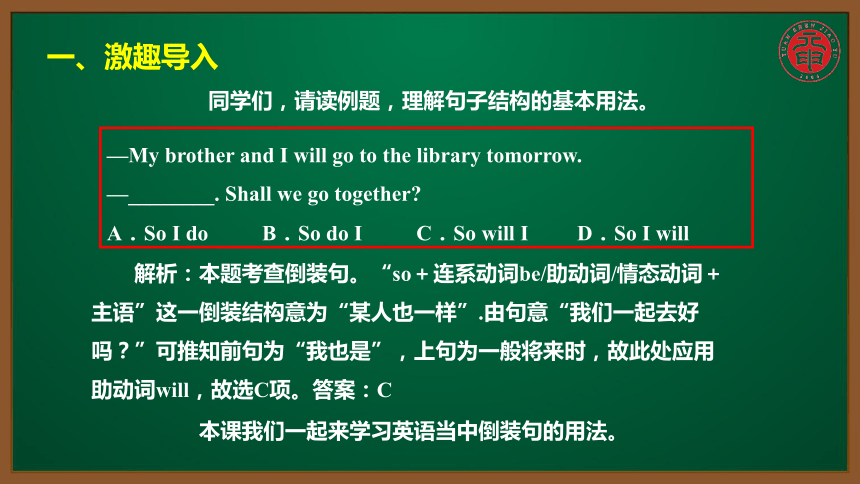
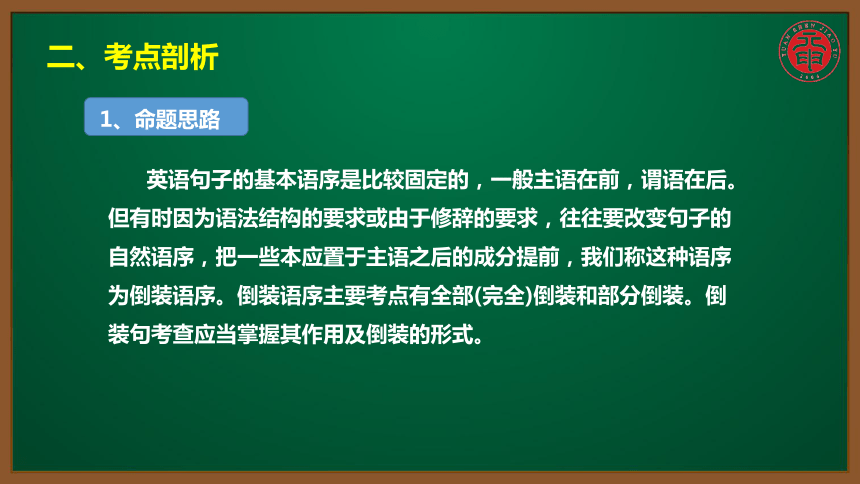
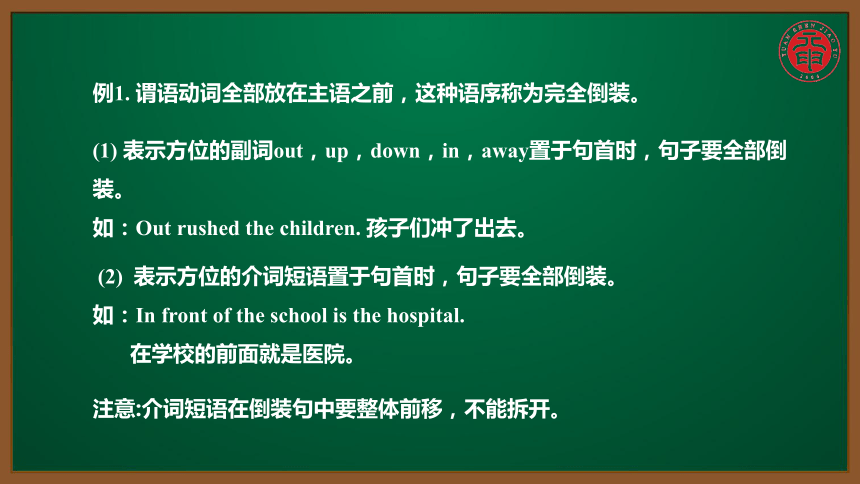
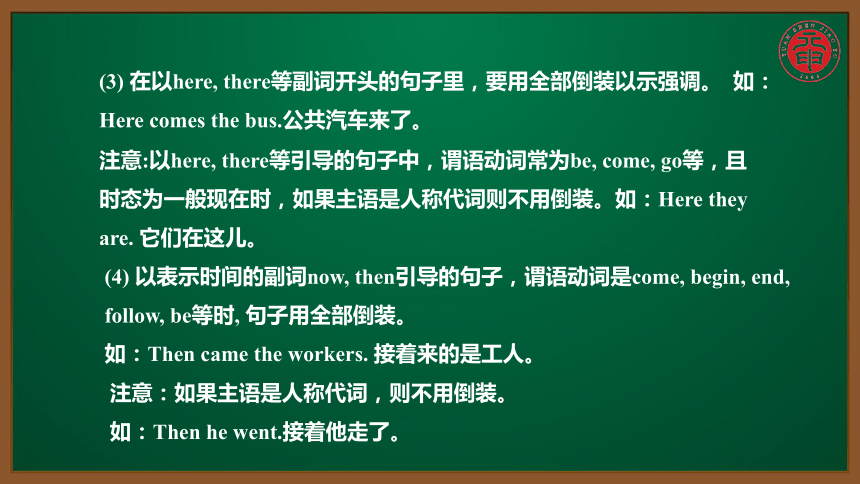
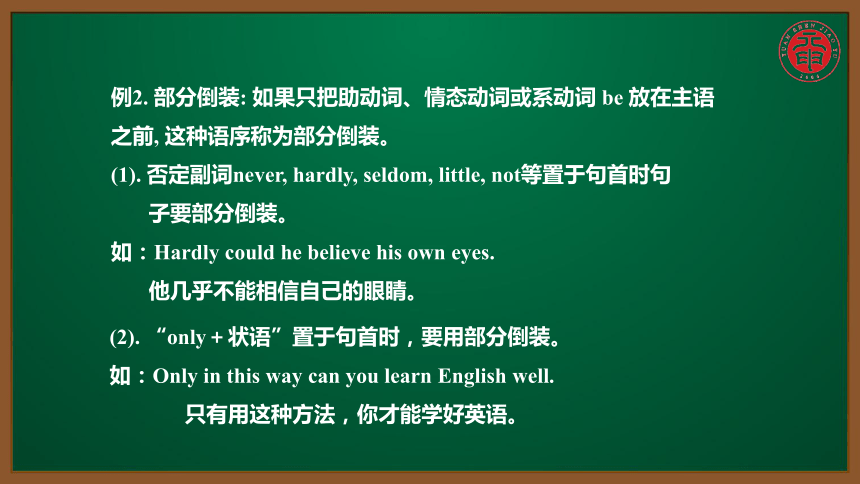
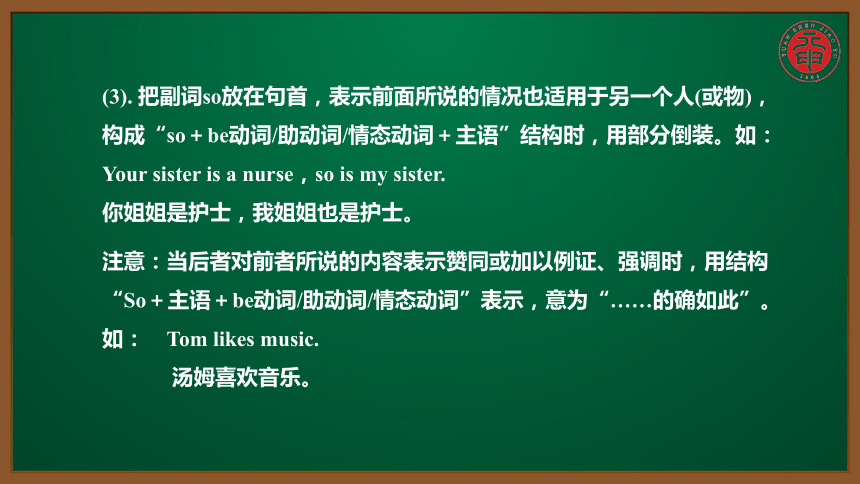
文档简介
倒 装 句
一、激趣导入
解析:本题考查倒装句。“so+连系动词be/助动词/情态动词+主语”这一倒装结构意为“某人也一样”.由句意“我们一起去好吗?”可推知前句为“我也是”,上句为一般将来时,故此处应用助动词will,故选C项。答案:C
同学们,请读例题,理解句子结构的基本用法。
—My brother and I will go to the library tomorrow.
—________. Shall we go together?
A.So I do B.So do I C.So will I D.So I will
本课我们一起来学习英语当中倒装句的用法。
二、考点剖析
1、命题思路
英语句子的基本语序是比较固定的,一般主语在前,谓语在后。但有时因为语法结构的要求或由于修辞的要求,往往要改变句子的自然语序,把一些本应置于主语之后的成分提前,我们称这种语序为倒装语序。倒装语序主要考点有全部(完全)倒装和部分倒装。倒
装句考查应当掌握其作用及倒装的形式。
(1) 表示方位的副词out,up,down,in,away置于句首时,句子要全部倒装。
如:Out rushed the children. 孩子们冲了出去。
(2) 表示方位的介词短语置于句首时,句子要全部倒装。
如:In front of the school is the hospital.
在学校的前面就是医院。
注意:介词短语在倒装句中要整体前移,不能拆开。
例1. 谓语动词全部放在主语之前,这种语序称为完全倒装。
(4) 以表示时间的副词now, then引导的句子,谓语动词是come, begin, end, follow, be等时, 句子用全部倒装。
如:Then came the workers. 接着来的是工人。
注意:如果主语是人称代词,则不用倒装。
如:Then he went.接着他走了。
(3) 在以here, there等副词开头的句子里,要用全部倒装以示强调。 如:Here comes the bus.公共汽车来了。
注意:以here, there等引导的句子中,谓语动词常为be, come, go等,且时态为一般现在时,如果主语是人称代词则不用倒装。如:Here they are. 它们在这儿。
例2. 部分倒装: 如果只把助动词、情态动词或系动词 be 放在主语之前, 这种语序称为部分倒装。
(1). 否定副词never, hardly, seldom, little, not等置于句首时句
子要部分倒装。
如:Hardly could he believe his own eyes.
他几乎不能相信自己的眼睛。
(2). “only+状语”置于句首时,要用部分倒装。
如:Only in this way can you learn English well.
只有用这种方法,你才能学好英语。
(3). 把副词so放在句首,表示前面所说的情况也适用于另一个人(或物),构成“so+be动词/助动词/情态动词+主语”结构时,用部分倒装。如:Your sister is a nurse,so is my sister.
你姐姐是护士,我姐姐也是护士。
注意:当后者对前者所说的内容表示赞同或加以例证、强调时,用结构“So+主语+be动词/助动词/情态动词”表示,意为“……的确如此”。
如: Tom likes music.
汤姆喜欢音乐。
把neither,nor放在句首,表示前面否定的内容也适用于另一个人
(或物),构成“neither/nor+be动词/助动词/情态动词+主语”结构时,用部分倒装。
例如:
—Mary didn't go to school yesterday. 玛丽昨天没去上学。
—Neither/Nor did I.我也没去。
注意:be动词/助动词/情态动词在形式上与前一句的谓语保持一致,而其数则由后一句的主语而定。
(5) not only...but also...连接并列的句子,前一部分倒装,后面部分不倒装;neither...nor...连接并列的句子,前后都倒装。
如:Not only does he learn to speak English,but also he learns to write in English.
他不但学说英语,他还学习用英语写作。
注意: 如果置于句首的not only...but also...连接两个并列主语,则句子不用倒装结构。
如:Not only he but also I like football.
不仅他而且我也喜欢足球。
单项选择,请选出正确的答案.
2、练一练
A
A
C
1. —Tom loves his classmates and teachers.—____.
A. So do I B. So I do C. Neither do I D. Neither I do.
2. —We have never been to Mexico. What about Jeff?
—____.He hopes to visit it someday.
A. Neither has he B. Neither does he C. So has he D. So does he
3. —I don't like documentaries.—____.
A. So do I B. So I do C. Neither do I D. Either do I
4. —Would you like to go fishing?—If Li Ping doesn't go,____.
A. neither will I B. neither have I C. so do I D. so will I
A
5.—Would you like to go to the amusement park?
—If Jack does,____.
A.I go,too B.so will I C.neither will I D.so do I
6.—I went to the park yesterday.
—____.But I didn't see you there.
A.So do I B.So did I C.Neither did I D.Neither I did
7.Our town has changed a lot,____.
A.so his has B.so has his C.so is hers D.so has he
8.I can't play the piano,and ____.
A.neither can my sister B.my sister can't,too
C.so can't my sister D.can my sister,either
A
B
B
B
3、答题技巧
倒装句的学习中掌握以下注意事情和技巧:
1. 当句首为副词here , there 且主语为名词时,应用完全倒装。
2. only 修饰时间、地点、方式等状语时,应用部分倒装。
3. 表示对前者的陈述也适用后者时,肯定倒装用“ so + 助动词/情态动词 + 后者”, 前句否定, 而后面的人也不怎么样时用“ neither / nor + 助动词 / 情态动词 + sb”。
4. 由 not only …… but also …… 引起的并列句,若将 not only 置
于句首时,该分句应部分倒装, but also 引导的分句不倒装。
三、思维导图
一、激趣导入
解析:本题考查倒装句。“so+连系动词be/助动词/情态动词+主语”这一倒装结构意为“某人也一样”.由句意“我们一起去好吗?”可推知前句为“我也是”,上句为一般将来时,故此处应用助动词will,故选C项。答案:C
同学们,请读例题,理解句子结构的基本用法。
—My brother and I will go to the library tomorrow.
—________. Shall we go together?
A.So I do B.So do I C.So will I D.So I will
本课我们一起来学习英语当中倒装句的用法。
二、考点剖析
1、命题思路
英语句子的基本语序是比较固定的,一般主语在前,谓语在后。但有时因为语法结构的要求或由于修辞的要求,往往要改变句子的自然语序,把一些本应置于主语之后的成分提前,我们称这种语序为倒装语序。倒装语序主要考点有全部(完全)倒装和部分倒装。倒
装句考查应当掌握其作用及倒装的形式。
(1) 表示方位的副词out,up,down,in,away置于句首时,句子要全部倒装。
如:Out rushed the children. 孩子们冲了出去。
(2) 表示方位的介词短语置于句首时,句子要全部倒装。
如:In front of the school is the hospital.
在学校的前面就是医院。
注意:介词短语在倒装句中要整体前移,不能拆开。
例1. 谓语动词全部放在主语之前,这种语序称为完全倒装。
(4) 以表示时间的副词now, then引导的句子,谓语动词是come, begin, end, follow, be等时, 句子用全部倒装。
如:Then came the workers. 接着来的是工人。
注意:如果主语是人称代词,则不用倒装。
如:Then he went.接着他走了。
(3) 在以here, there等副词开头的句子里,要用全部倒装以示强调。 如:Here comes the bus.公共汽车来了。
注意:以here, there等引导的句子中,谓语动词常为be, come, go等,且时态为一般现在时,如果主语是人称代词则不用倒装。如:Here they are. 它们在这儿。
例2. 部分倒装: 如果只把助动词、情态动词或系动词 be 放在主语之前, 这种语序称为部分倒装。
(1). 否定副词never, hardly, seldom, little, not等置于句首时句
子要部分倒装。
如:Hardly could he believe his own eyes.
他几乎不能相信自己的眼睛。
(2). “only+状语”置于句首时,要用部分倒装。
如:Only in this way can you learn English well.
只有用这种方法,你才能学好英语。
(3). 把副词so放在句首,表示前面所说的情况也适用于另一个人(或物),构成“so+be动词/助动词/情态动词+主语”结构时,用部分倒装。如:Your sister is a nurse,so is my sister.
你姐姐是护士,我姐姐也是护士。
注意:当后者对前者所说的内容表示赞同或加以例证、强调时,用结构“So+主语+be动词/助动词/情态动词”表示,意为“……的确如此”。
如: Tom likes music.
汤姆喜欢音乐。
把neither,nor放在句首,表示前面否定的内容也适用于另一个人
(或物),构成“neither/nor+be动词/助动词/情态动词+主语”结构时,用部分倒装。
例如:
—Mary didn't go to school yesterday. 玛丽昨天没去上学。
—Neither/Nor did I.我也没去。
注意:be动词/助动词/情态动词在形式上与前一句的谓语保持一致,而其数则由后一句的主语而定。
(5) not only...but also...连接并列的句子,前一部分倒装,后面部分不倒装;neither...nor...连接并列的句子,前后都倒装。
如:Not only does he learn to speak English,but also he learns to write in English.
他不但学说英语,他还学习用英语写作。
注意: 如果置于句首的not only...but also...连接两个并列主语,则句子不用倒装结构。
如:Not only he but also I like football.
不仅他而且我也喜欢足球。
单项选择,请选出正确的答案.
2、练一练
A
A
C
1. —Tom loves his classmates and teachers.—____.
A. So do I B. So I do C. Neither do I D. Neither I do.
2. —We have never been to Mexico. What about Jeff?
—____.He hopes to visit it someday.
A. Neither has he B. Neither does he C. So has he D. So does he
3. —I don't like documentaries.—____.
A. So do I B. So I do C. Neither do I D. Either do I
4. —Would you like to go fishing?—If Li Ping doesn't go,____.
A. neither will I B. neither have I C. so do I D. so will I
A
5.—Would you like to go to the amusement park?
—If Jack does,____.
A.I go,too B.so will I C.neither will I D.so do I
6.—I went to the park yesterday.
—____.But I didn't see you there.
A.So do I B.So did I C.Neither did I D.Neither I did
7.Our town has changed a lot,____.
A.so his has B.so has his C.so is hers D.so has he
8.I can't play the piano,and ____.
A.neither can my sister B.my sister can't,too
C.so can't my sister D.can my sister,either
A
B
B
B
3、答题技巧
倒装句的学习中掌握以下注意事情和技巧:
1. 当句首为副词here , there 且主语为名词时,应用完全倒装。
2. only 修饰时间、地点、方式等状语时,应用部分倒装。
3. 表示对前者的陈述也适用后者时,肯定倒装用“ so + 助动词/情态动词 + 后者”, 前句否定, 而后面的人也不怎么样时用“ neither / nor + 助动词 / 情态动词 + sb”。
4. 由 not only …… but also …… 引起的并列句,若将 not only 置
于句首时,该分句应部分倒装, but also 引导的分句不倒装。
三、思维导图
同课章节目录
- 词法
- 名词
- 动词和动词短语
- 动词语态
- 动词时态
- 助动词和情态动词
- 非谓语动词
- 冠词
- 代词
- 数词和量词
- 形容词副词及其比较等级
- 介词和介词短语
- 连词和感叹词
- 构词法
- 相似、相近词比较
- 句法
- 陈述句
- 一般疑问句和否定疑问句
- 特殊疑问句及选择疑问句
- 反意疑问句
- 存在句(There be句型)
- 宾语从句
- 定语从句
- 状语从句
- 主谓一致问题
- 简单句
- 并列句
- 复合句
- 主谓一致
- 主、表语从句
- 名词性从句
- 直接引语和间接引语
- 虚拟语气
- 感叹句
- 强调句
- 倒装句
- 祈使句
- 句子的成分
- 句子的分类
- 题型专区
- 单项选择部分
- 易错题
- 完形填空
- 阅读理解
- 词汇练习
- 听说训练
- 句型转换
- 补全对话
- 短文改错
- 翻译
- 书面表达
- 任务型阅读
- 语法填空
- 其他资料
